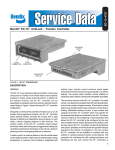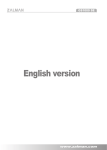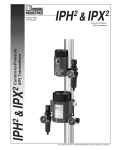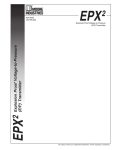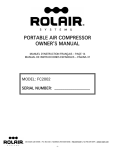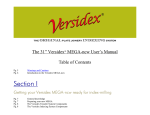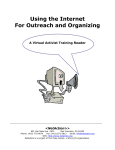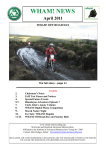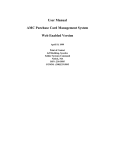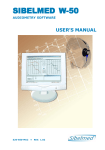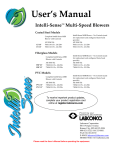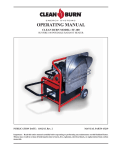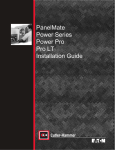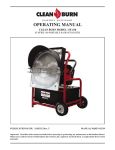Download Assembly & Set-Up Instructions for the 31” Versidex ® MEGA-ncw
Transcript
the original plate joinery indexing system 61 Elm Street Hatfield, MA 01038 413-247-5969 www.versidex.com Part II Assembly & Set-Up Instructions for the 31” Versidex® MEGA-ncw Indexing Accessory Fixture: 3 hours, 45 minutes Complete Part I, the “Assembly Instructions for the 31” Versidex® MEGA-ncw Rolling Stand” before starting here! Please track the time it takes you to assemble your unit. Our assembly time is skewed because of our experience and practice. We’d like to know the real-world average time it takes for first-time-through-it customers. Thanks for your help on this. For your trouble and your email address, we’ll offer you discounts on accessories in the future through special emailings. 1. UNPACKING THE VERSIDEX MEGA-ncw: a. You have already opened the palletized container and removed the MOBILE BASE, the LOWER SHELF, the 3 VERTICAL TEMPLATES, the extra PLATFORM TEMPLATE, the 13x13x7” or 12x12x6” carton, the 2 arched, decaled and transfer masked STRETCHERS and scrap, and the CROSSBEAM. The bottom of the container should still be UNDER the MEGA, and ON the shipping pallet. 2 b. Stand at the end of the MEGA so that you cannot see the AIR CLAMPING SYSTEM, the “neon lime green” CROSSPANEL is closer to you than if you stood at the other end, and you CAN see the “DUST IS THE ENEMY” Versidex decal. This is the INFEED or FRONT end of the MEGA. This end position is where you will do your joinery work. c. Break down the front of the carton’s bottom and remove the pad just inside it to expose the orange-tan strip that is the FRONT NOSE of the installed PLATFORM TEMPLATE. Using some care to make sure you have cleared the pathway, ease the template out of its guiding slots by pulling it straight out the whole way, but NOT UP or DOWN. d. Set this template aside with the other large template you unpacked earlier, but STAND them nearly VERTICAL, or lay them COMPLETELY FLAT. 2. LIFTING THE MEGA ONTO THE ROLLING BASE: a. GET A HELPER or two: This is a heavy lift. b. Position your newly assembled ROLLING STAND next to the MEGA, with one of the STRETCHERS facing, or parallel to, one of the MEGA’s sides. The stand’s top leg rails will be PERPENDICULAR to the MEGA. It doesn’t matter yet which stretcher is closest. c. With you at the FRONT of the MEGA (can’t see the air clamping system) and your helper at the REAR, lift the MEGA from the cardboard bottom and place it atop the ROLLING STAND without ROTATING it, and just roughly position it so it’s balanced and stable for now. d. DO NOT PEEL the masking from the decals yet. REALLY! They’re somewhat protected for now. Leave them protected. e. Remove the rest of the shipping container material and the pallet from your working open area. 3. TAPPING IN THE LOCATING PINS: a. Locate the 4 1/4 x 1-1/4” steel pins in bag #4 in the 13x13x7” or 12x12x6” carton. The end of the pin that is slightly more tapered or beveled than the other is inserted first. b. TOOLS: steel hammer or wooden handscrew c. Using the steel hammer, tap the pins into the four UNDERSIDE corners of the MEGA, putting the more tapered or beveled end in first. The proper holes are those CLOSEST to the platform’s corners. d. These are a TIGHT fit, but use as LIGHT a series of TAPS as possible, putting some resistance against the top surface. You should feel them bottom out, but you want to end up with about 1/2” of pin remaining out. That length is not critical. These are your corner locating pins. No glue is required. A handscrew also works, but takes some finesse. 3 4. ROTATING THE MEGA & MATING THE LOCATOR PINS: a. GET A HELPER: You’re lifting again. b. With both of you lifting from the same positions as before, you’re going to raise the MEGA and rotate it 90°. Now you DO need to know where the FRONTs of both the STAND and the MEGA are. Remember that the rolling stand’s REAR stretcher has the small holes facing the INSIDE of the STAND, and the FRONT of the MEGA blocks your view of the AIR CLAMP ASSEMBLY. c. Figure out which way you’re going to rotate, and then lift the MEGA, rotate it in the proper direction and replace it on the STAND. Take a peek UNDERNEATH and determine how to move the MEGA so that the pins will drop into the holes closest to the ENDS of the leg rails. Get the four pins seated, tapping the top rails of the stand with a soft mallet if you need to adjust the holes. d. DO NOT peel the decal maskings yet! REALLY! Leave them protected for now! 5. INSTALL THE UNDERMOUNT KNOBS: a. Locate the 4 undermount knobs with 1/4-20 studs, in Bag #4 in the 13x13x7” or 12x12x6” carton. b. Stand at the FRONT of the MEGA, and looking underneath, find the leg rail hole immediately behind the FRONT locating pins, one on the left and one on the right. Thread a knob into each of those 2 inserts firmly, but just snug. You may have to tap the leg assemblies a bit to center the inserts. DO NOT crossthread the knobs. MAKE ADJUSTMENTS FIRST. c. GO to the REAR of the MEGA and find the other pair of inserts just behind those REAR locating pins. Thread a knob into each of those 2 inserts firmly, but just snug, adjusting the legs if necessary so as not to crossthread the knobs. MAKE ADJUSTMENTS FIRST. 6. THREADING-IN THE CROSSBEAM SPINDLE: a. Locate the 3/8”x6” spindle and its 4” handle in Bag #4 in the 13x13x7” or 12x12x6” carton. Also find the two large washers, and 3 nuts in Bag #4. b. TOOLS: 2 wrenches, both 9/16”, one can be adjustable. c. In the center of the CROSSBEAM under the platform, you’ll find a vertical hole. d. Thread one nut onto the spindle and run it on about 1”. Thread the handle onto the spindle, and run the spindle in until it stops, and then back it off 1/4 of a turn. Bring the nut down until it stops and then use the wrench and the handle itself to tighten (jam) that nut against the handle firmly. Try to keep the handle and the spindle from rotating against each other while tightening down the nut. 4 e. Slip 1 washer onto the spindle. Reaching in from the FRONT of the MEGA, slide the spindle into the vertical crossbeam hole from below, and push it up, just until the end appears above the crossbeam. Add the other washer and then the 2 nuts, and run the nuts down the spindle about 3/4” or so and STOP. f. Pushing up on the spindle, find the insert in the underside of the MEGA, and thread the spindle into it. Move the 2 top nuts up or down as necessary. It should feed easily. Do not cross-thread it. g. Thread the spindle in until the handle/nut/washer assembly below tightens up against the crossbeam and then STOP. Back it off just until it feels loose again. STOP. h. Run the nuts that are above the crossbeam down until the spindle is nicely sandwiched by the 2 washers. The washers, above and below, should be loose, but not sloppy. The spindle should rotate freely, but once tested, leave it in its loose, “neutral” position. i. When you are satisfied that the spindle is adjusted properly, lock (jam) the 2 nuts together using both wrenches, trying not to move the bottom nut up or down. j. You have just set the inflection and convexity PLATFORM ADJUSTER on your new MEGA-ncw. k. By rotating the handle to the RIGHT (re the front surface of the handle), you can increase the inflection or “cup” in the platform’s surface. This adjustment will take a HUMP out of the platform by bringing its surface back to true flat. l. By rotating the handle to the LEFT (re the front surface of the handle), you can increase the convexity in the platform’s surface. This adjustment will take any SAG out of the platform by bringing its surface back to true flat. m. More information on these adjustments is included in the “User’s Manual for the Versidex MEGAncw Indexing Accessory Fixture”. Leave the handle in the loose, “neutral” position for now. 7. REMOVING THE DECAL MASKING: a. FINALLY! Take a 3” wood block or scrap and break the edges to give yourself a round over of 1/8” or so. This will be your pressure squeegee. Pick a decal to do. b. Starting in the center and working outwards, apply just moderate pressure to the masking as a final assurance that the decal hasn’t peeled up or hasn’t an air bubble under it. If you need to work an air bubble to the edge, use more pressure. Go slowly and remember that by rubbing on the masking you won’t be rubbing the decal surface itself, which can scratch it. c. Once completed, lift any corner of the masking sheet, and slowly begin to peel it off. TRY TO KEEP the masking sheet in your hand at about a 135° angle to the deposited decal. Less or more of an angle than that and you run the risk of lifting the decal, too. d. Once the masking is peeled off the decal is done. If the decal comes loose during the process, lay it back down, with the masking over it and try again. The adhesive will strengthen over the next couple of weeks. 5 8. THRU-FEEDING THE AIR HOSES: a. Now we have to get the MEGA ready to work. Stand at the front of the MEGA. There is a left side and a right side. The AIR INFEED ASSEMBLY is located on the INSIDE of the RIGHT SIDE, behind the Crosspanel. b. TOOLS: ¾” open end wrench, 5/8” open end wrench, #2 PH screwdriver or power driver c. Identify the RED 3/8” air line, unscrew the P-clamp at the BLACK SPACER STRIP (between the RIGHT SIDE and the T-TRACK), but note that there are two screws. The screw on the left goes through the top hole, and then through the REAR bottom leaf hole. The second screw on the right goes through the remaining FRONT hole in the bottom leaf. Put the screws some place safe. You’ll need them again. d. Next, you’re going to remove a section of the BLACK indicator strip. Put a very small bladed screwdriver into the middle hole in the BLACK spacer strip, and another or your little finger into the hole under where you removed the hose clamp. LIFT OUT the short section of spacer strip that is loose. You may need to pry it out a bit if it’s tight, but it is not being held by any glue or fastener. You may have to work around the black drain hose attached to the regulator/filter bowl. Use wire cutters to clip the restraint on the RED HOSE and unwind the loop in it so that it’s now straight. e. Feed the RED air hose into the hole furthest from the air infeed assembly, until it forms a nice curve as it runs up to the air assembly. That’s fine for now. It will run down on the OUTSIDE of the leg rail when it exits the platform below. f. Locate the coiled clear-blue air hose in the 13x13x7” or 12x12x6” carton, and unpack it. Locate the blow gun also, but DO NOT attach it yet. REALLY! g. Taking the coiled clear-blue air hose, you’ll notice that one end has a longer straightened end than does the other. Hold that longer straightened end and feed it UP through the hole in the platform that is also OUTSIDE the leg rail, and directly below the AIR INFEED ASSEMBLY. Pull through enough so the hose won’t fall back down the hole. h. Unbind the black drain line that comes off of the filter/regulator bowl straighten it out, and while taking the black spacer strip in one hand and the end of the drain line in the other, push the drain line through the spacer strip starting on the black laminate side. Feed the drain line down its hole under the regulator bowl. Get the strip and drain line oriented so that the strip is fairly close to going back in place. Fit the NOTCH in the strip over the blue hose, then butt the half circle (left) end against the RED hose, and finally drop the little section back into place, readjusting things as you work it home. There should be no slack left in the ¼” black drain hose when you are finished. i. Now PUSH the clear blue hose BACK DOWN the hole until it stops. It has stopped at the plastic “spring”. Compress this spring against the black spacer strip, and fit the threaded male fitting into the port on the underside of the air distribution block. This can be a little tricky and frustrating, but the following might help: j. The female port will be directly above the blue air hose’s hole in the platform. We find it easier to line up when we stand at the OUTFEED end of the MEGA, and lean in until we’re looking directly at the air infeed assembly. Thread the hose’s male end into the port. The end already has Teflon sealant applied to 6 it. You will notice that the end fitting will swivel, so you can screw the end fitting into the port without having to twist the air hose around and around with it. k. The swivel is stiff, so be patient and take your time. Once the threads are started, and you’re ready to finish with a wrench, stand at the true RIGHT side of the MEGA and lean over the air infeed assembly. Use the wrench in your left hand, and with your right hand, press hard on the air infeed assembly to counteract the forces from the wrench. Too much wrench and not enough counterforce will put great strain on the bracket screws and could strip them out or break the bracket. Use care. This fitting must be quite tight or it will leak, BUT DO NOT test it for leaks yet. REALLY! WAIT! NOTE: Be careful not to hit the Lexan bowl on the air filter with the wrench. You know why. l. At the RED hose, shape the curve the hose makes from the air assembly so that it comes up from the black spacer strip at 90° for a few inches and then begins to curve. Slip on the black “P” shaped hose restraint that you removed earlier, and slide it back down until it is at the SURFACE of the black spacer strip. Use the removed screws to reattach the “P” clamp. REMEMBER to use the REAR bottom leaf hole first, so the clamp is tight around the hose, and the hose won’t move up or down easily. Getting this first screw back in can take a few tries, so expect a little trouble. Then add the second screw which is much easier to reinstall. 9. FINISHING UP WITH THE AIR HOSES: a. Locate the 2 white cup hooks and white-headed screws package, the quick-disconnect, and a D-ring & one slotted hex head #14 x 1” screw in Bag #5. b. TOOLS: power driver with a #2 PHILLIPS tip, 5/8” open end or adjustable wrench, 7/16” nut driver or socket & ratchet c. On the OUTSIDE of each SIDE, you’ll find 2 screw holes near the FRONT (infeed end). Attach the 2 hooks using these holes. You’ll hang the blow gun on either of these hooks. d. Take the loose end of the clear-blue air hose and feed the hose toward the FRONT of the MEGA, passing it OVER the CROSSBEAM, which takes some maneuvering. Next, decide which hand you are likely to use the blow gun in, left or right? If the RIGHT HAND, “curl” the hose through the top RIGHT electrical box hole, on the RIGHT leg. Put just a bit of tension on the hose up to the leg pass-thru. Adjust the hose to straddle the crossbeam and again at the opening in the leg to lock it in place. For LEFT HANDED use, use the LEFT leg and electrical box hole. You can always change it later. e. Attach the blow gun and air pressure regulator to the end of the hose. Use Teflon thread tape if you have it. Holding the wrench in one hand and the blow gun in the other will work. HANG the blow gun from the hook on the right side for now. Work out any twists or tangles. It should hang in a nice, smooth loop. f. Attach the female FNPT quick-disconnect MALE plug to the loose end of the RED air hose, if it is compatible with your compressed air fittings (shop standard IND [Industrial Interchange]). If you opted to buy a Rolair compressor, it will be compatible, so attach it. 7 g. Take the D-ring, washer and screw and find the screw hole 3” in on the UNDERSIDE of the platform at the INFEED end, exactly in the center from side-to-side. Tighten the screw until just SHORT OF snug, and the D-ring is to the FRONT and the screw and tab are to the REAR. The D-ring should easily rotate, but not flop around. Adjust the screw as necessary. h. Your air supply is ready, but DO NOT apply compressed air to the MEGA yet! There is a checklist to go through so that you won’t wreck the air system. PLEASE wait! REALLY! Move on to this now: 10. ATTACHING THE FLIP-UP SHELVES: a. Locate the 2 flip-up shelves in the 13x13x7” or 12x12x6” carton. And the flip up shelf screws from Bag #6 b. TOOLS: power driver with a #2 PHILLIPS tip, a PH screwdriver will work, but there are 24 screws to drive; maybe a small hammer, or a block of scrap wood. c. These flip up shelves are the SIDE TOOL RESTS for your joiner to sit on. They sit at an incline. Their mounting holes are predrilled on the OUTSIDEs of the sides, near the FRONT of the MEGA. d. The shelves are ambidextrous, so neither is a specific left one or right one yet. Take one shelf and turn it over so the brackets are facing up. LIFT the bracket ends UP until they snap into the open position. There will be some play in the legs. e. This next part is a little tricky. Put the shelf face down on your bench so the legs are pointing straight up and are AWAY from you. With one hand in the center of the shelf to hold it down, grasp one of the angled struts by its sides, down near the bottom, using your thumb and fingers, and lift the end free of the horizontal bracket leg. f. There will be a lot of spring tension. Keep pivoting it all the way up to the vertical leg. The spring will pass over a pivot “hump” and then pull the strut firmly to the vertical leg and remain there. The vertical bracket leg will now be flopping loosely. This is okay for now. Do the other bracket the same way. Following these steps will allow you ACCESS to the top screw holes, which are otherwise blocked. g. Take a shelf and load a screw on your PH driver tip. Insert the screw through a TOP hole of one of the floppy bracket legs and find the proper matching hole in the MEGA’s side. Drive that screw and then immediately drive a top screw in the OTHER bracket. h. Check that the bracket holes and the predrilled holes all line up and tap them into place with a hammer and/or block of wood if they don’t. They will move fairly easily. There are 6 screws in each bracket leg. Install all 12 of them. Finally, while holding the shelf up, grasp the spring loaded, angled part again and move it back to its original position. You’ll pass over the “hump” again and the tension will suddenly increase, so hang on tightly and don’t let your fingers get pinched. i. You’re done with that one. To drop the shelf, PRESS the two tabs at the outside-most ends of the brackets and lower the shelf. Ooh, that’s nice! Leave it UP for now. There’s more to do on these. 8 j. Repeat the above steps to attach the other shelf. 11. ATTACHING THE RUBBER TOOL HOLDER BUMPERS: a. TOOLS: If you have purchased a Lamello joiner, or told us that you will using a compatible Lamello joiner you already have, the flip-up shelves have been pre-drilled for the rubber bumpers. If you do not or won’t have a Lamello joiner, you will need the following tools: an awl and mallet or hammer, some tape or 1” spring clamps; power driver with a #2 PHILLIPS tip, a screwdriver won’t cut it this time… b. Locate the 6 rubber bumpers and 6 #6 x 1” PH screws in Bag #6. If you will be using another brand, we have no information on them, so read through these instructions and see if you can create the proper locations for your joiner. c. If you told us when ordering that you had a compatible Lamello joiner, we’ve pre-drilled the mounting holes for you. Use one screw into one bumper in each of the three holes on each flip up shelf. Tighten down the screw just until you can’t rotate the bumper with your fingers any more. Too much pressure will pull the screw right through the bumper. DON’T do that. That finishes #11 for Lamello owners. For other brands, your shelves will not have been pre-drilled, so you’ll have to create your own bumper pattern. See the next item, 11d. d. We have included two paper templates to mark out your locations. REMEMBER: The two shelves have bumper patterns that are NOT the same, nor are they MIRROR images of each other. DO NOT get confused. The criteria to keep in mind is that you want the two OUTSIDE bumpers to be .75” in from the outside shelf edge, and the two INSIDE bumpers to be the width of the soleplate plus .5”. BUT, make sure that no tabs, levers, or obstructions are in the way of where you want to place these bumpers up and down on the shelf. We like to be about 1.5” back from the front nose of the joiner or so, when resting in place, and this is determined by the BOTTOM bumper: e. The bottom bumper must be clear of any obstructions that your joiner has at its rear edge. The dust port and hose are the usual obstructions on the right side, so like with the Lamello joiners, that third bumper will usually be set off to the LEFT of center. Position the one-per-shelf BOTTOM bumpers equally from the bottom edges of the shelves, about .75” off of that edge. f. When your bumper positions are located, clamp the pattern to the correct shelf, and punch the center points with an awl, making a mark just deep enough that you can use it as the starter hole for the screws. You don’t have to predrill for the MDF. g. Each punched location takes a black bumper and a #6 x 1” screw. Tighten the screw just to the point where the bumper won’t turn anymore; if you drive it in too far, it will pull the screw through the rubber. 12. THREADING THE JOINER POWER CORD AND DUST COLLECTION HOSE: a. If you ordered the iVac Switch Box controller, locate it in the 13x13x7” or 12x12x6” carton. Locate the 6 Velcro strips in Bag #6, plus the one you removed from the ¼” condensate tube on the air clamp system. Also locate the 4 white-headed screws. 9 b. The iVac device mounts in the predrilled holes on the INSIDE FACE of the REAR stretcher. Install this unit using the 4 white-headed screws. c. Take your biscuit joiner and place it on one of the flip-up shelves so that the bumpers hold it in place. Thread the plug end of the power cord through the D-ring under the platform. Run it over the stretcher, over the crossbeam and then to the iVac and plug it into the proper receptacle. This is good for now. d. Take your joiner’s vacuum hose, attach it to the joiner if it isn’t already, detach it from any vacuum, and thread the hose through the D-ring, over the stretcher and UNDER the crossbeam and that’s good for now, too. Some hoses are too big to fit through the 2” D-ring. We can’t source a larger diameter Dring at this time. Not sure why. We try to question our customers about their vacuum choice and therefore hose end fittings diameter to avoid this problem. e. We like the Lamello hose for its 1” diameter and very light weight, but if your joiner is not a Lamello, you’ll have to figure out how to make it work with it, if you opt for that hose. Your other option that we think will work is to use the restraint cord. We’ll tell you how to use that to secure the hose in a second. f. Gather the power cord and hose together as close to the joiner itself as seems practical, and secure a black Velcro Self-Grip tie tightly around both. Repeat the ties every 6-8” or so until used up. It is unlikely you will ever need to use your joiner WITHOUT the hose, so binding them together should not be an issue, but the binding is easily reversible should you want to undo it and use your hose-less joiner elsewhere. We strongly believe that your Versidex should have its own dedicated joiner, however. g. Standing at the FRONT of the MEGA, pull enough slack back on the cord & hose such that about 40” of both are BETWEEN the D-ring and the joiner itself. You can customize this free length as you get used to using the MEGA, but start with 40”, and adjust your Velcro straps’ spacing as necessary. h. Locate the BLACK 1/8” x 24” rope with wooden ball ends in Bag #6. This is used to hold the cord & hose in place without being at all permanent. The wooden balls keep weight on the rope, which keeps it from loosening too much. i. Double up the rope, slide the loop end through the BOTTOM of the D-ring or split ring, curl the loop around to the FRONT and pass the wooden balls through the LOOPED end of the rope. Pull that knot (two half-hitches) tight, positioned at the BOTTOM of the ring. j. Now take the balls and split them apart, and pass them up and over the cord & hose from opposite directions, passing some in FRONT of the ring and some BEHIND the ring, repeating this until the rope is used up, but the balls can still hang. This is all that is needed. DON’T tie a knot. You may want to remove your joiner for other projects, and you want that to be easily done. This method will keep the cord & hose at 40” from the ring to the joiner, while also allowing them to swivel as necessary for less resistance. k. If you have to suspend the hose from the D-ring, use the restraint cord, but keep passing the balls THROUGH the D-ring from both the front and the rear, and this will secure the hose. l. If you think 40” is too long, stand your joiner on its nose and push it up against the LEFT fence, and TIGHT against the CROSSPANEL. This is the maximum length of hose you’ll need when you’re 10 making any of the possible cuts. The hose needs to arch up a ways before turning down, so as not to kink. Adjust the overall length from joiner to D-ring if necessary. 13. INSTALLING A TEMPLATE SET: a. Locate the pre-marked, white PLATFORM TEMPLATE (a big one, RED and BLACK lines). b. Remember pulling this out of the MEGA while it was still in the container? It goes back in by reversing what you did, lining it up just under the T-tracks and sliding right in until the nose bumps the front of the platform. c. Locate a pre-marked VERTICAL TEMPLATE (small one, RED and BLACK lines). d. Lift out the SPRING CLOSERS at the LEFT and RIGHT sides of the CROSSPANEL. Fit the template’s end tab holes over the MOUNTING PINS in the CROSSPANEL, and press the template against the CROSSPANEL. e. CLOSE the spring closers onto the template for now. DONE. 14. PREPARING THE AIR SYSTEM ASSEMBLY: a. Locate the short handle with a blue knob in Bag #6. b. Screw the handle tightly into the top edge of the air valve, which sits at the top of the CROSSPANEL above the PRESSURE BAR and directly behind the “Dust is the Enemy” decal. The label shows the valve positions, either ON or OFF. ON will activate the system, dropping the pressure bar. OFF shuts off the air to the pressure bar and allows the cylinders to vent. The pressure bar is lifted to idle by internal cylinder springs. c. Adjust your compressor’s output pressure to 80-90psi. This is the necessary working pressure of the air clamp with a melamine template surface and melamine panel stock less than 12” wide, the slipperiest combination. d. Now connect the RED air hose to your compressed air source, whether an on-board compressor or a shop supplied line. e. Look at the FILTER/REGULATOR gauge at the air assembly and adjust it as necessary until it reads 80 lb/psi. This is what is needed for the pressure bar to do its job. More pressure than that unnecessarily stresses the fixture. You have to LIFT the top knob on the regulator and then turn it to adjust the pressure. 11 f. At each .25” black air line fitting, make sure the tubing is securely seated into the fitting. If any tube seems to not be lying flat and out of the way, trying twisting the tube at the fitting with your fingers. This is not normally an issue. g. Look at the PRESSURE BAR from the REAR of the MEGA. Notice the WARNING sign: DANGER OF CRUSHING. Please, please, PLEASE take this warning seriously. WARNING: It is very unlikely that an operator could crush his or her own fingers. We have set up the MEGA so that this cannot happen in normal use. BUT, there are two scenarios that you must AVOID. The first is having two people working around the MEGA. Work alone at the MEGA and be safe. The second is being in a hurry and activating the air clamp from the REAR side, where your other hand could be at risk. NEVER, NEVER, NEVER operate the air clamp from the side or rear of the MEGA. ALWAYS be at the infeed area when you move the air clamp lever to “ON”. h. Locate two pieces of scrap of equal thickness AT LEAST 3” wide and slide them under the CROSSBEAM and the PRESSURE BAR, one against the LEFT FENCE and one against the RIGHT FENCE. The arched cut offs from the STRETCHERS that you set aside will do nicely. i. NOW it’s time to test the AIR CLAMPING system. Move the blue AIR CLAMP knob from the RIGHT OFF position to the LEFT ON position. You should hear the pressure bar drop. Test to see if your scrap pieces can be moved with just moderate pressure. Probably not and the system is READY TO GO. But if they do move increase the regulator pressure to 85psi and try again. Move the handle to the OFF position. You will hear the residual air being expelled as the pressure bar lifts to idle. 15. WRAPPING UP THE ASSEMBLY: a. Here is where a ton of variables come into play and make the final part of setting up very complicated. You have to address the following questions: b. If you are creating a self-contained, dedicated workstation so that you can wheel it around your shop or factory floor, hook into power, and be ready to do work, you’ll need to install your air compressor and vacuum on the lower shelf. c. In addition to those machines, you will also need to power your joiner, so you’re looking at two separately protected 15amp feed circuits. d. The iVac Switch Box controller model we recommend, if you purchased one, will control the 3 devices. e. We highly recommend that you add a simple primary dust separator at the rear of the MEGA if your milling sessions will be 4 hours or more. If you have one or purchase one with wheels, a simple band/strap/web clamp holding it to the legs of the MEGA will preserve the MEGA’s self-contained mobility. f. Or, if your slip-tenon joinery production is VERY high, we recommend that you bring a flexible shop/factory dust collection system line to the MEGA. All of your decisions need to be based on our mantra: “Dust is the Enemy”. The template surfaces must be kept clean and free of dust. Your vacuum hose at the joiner must be performing at or above 175cfm/60”sp of suction. More on those specs below. 12 Our opinions on air compressors and vacuums: The pressure recovery rates of air compressors are not very important in the MEGA environment. The air clamping system requires very little air and the blow gun is only used in short bursts. Tube-tank types of 1.5-2 gallons are sufficient, and will allow more room for the vacuum system than will pancake or pot-belly types. With your joiner and vacuum running, what difference does the Db level of the air compressor make? There’s going to be a lot of noise regardless. That said, we favor the quieter ones (60 Db or so) for any situation where the compressor might be used for other purposes than just with the MEGA. As for vacuums, static lift is generally more important, but not always. Velocity, or CFM, at the collection point is VERY important in the Versidex MEGA environment. The available intake area at a joiner’s mouth, minus the blade, is less than a .75” diameter hose at the moment of deepest plunge, when the creation of dust and debris is at its maximum. Working those two things together, we suggest a CFM over 175 and static lift over 60”. These efficiencies are minimums and are only maintained with regular servicing and maintenance. As for size, once you decide on your air compressor, fit in as large a vacuum as possible to extend cleaning intervals. We offer a 10-gallon canister rated at 195cfm/60”sp. It’s loud, but very effective. If you want even more power, you might be able to use the alternate mounting location for the lower shelf in order to gain more storage room, but that won’t benefit the canister vacuum design. Also consider adding an add-on dust separator as mentioned above. If you devise a particular combo that works on the shelf space, please let us know and we’ll post it so others can consider your solution. Hardware bags in the 13x13x7” carton to use for Setting Up the MEGA: Bag #4 4 each of: 1/4” x 1-1/4” steel pins black knobs with integral 1/4"-20 studs, with 2 jammed nuts if stud is longer, and 1 self-retaining nylon washer 1 each of: 3/8” x 6” threaded rod (the spindle) 4” black handle 2 each of: large flat washers, 1” OD 3 each of: 3/8”-16 hex nuts Bag #5 1 package of 2 white hooks, with screws 1 each of: 2” D-ring washer ¼” x 1” lag screw 3/8” FMPT male plug Quick-Disconnect fitting (for RED air hose) 13 continued: Bag #6 6 each of: Rubber bumpers #6 x 1” screws for the rubber bumpers Self-sticking Velcro wrap strips 4 white headed, #6 screws 12 each of: Small screws for flip up shelf brackets 1 each of: Black cord with wooden balls Handle with a blue knob You are ready to use your new Versidex MEGA-ncw. Go back to Instructions on the Menu bar, and click on the User’s Manual to get started. Enjoy your Versidex journey! © Versidex, LLC 2014













